Evergreen Content
What is Evergreen Content?
Evergreen content is content that remains relevant and useful over time. It is not tied to a specific event or time period and can be used long after it is created.
This type of content is often timeless and can be used over and over again.
As opposed to timely content that is only relevant for a few months or even days, evergreen content is consistently valuable throughout time and does not require frequent updates.
Although, regularly updating content is also one of the things that can make it evergreen.
Evergreen Content Benefits
Publishing evergreen content on your website has many benefits, but these five are the biggest.
1. Is always relevant and useful
Evergreen content does not go out of date or become irrelevant like news stories or trend pieces. It can be relied upon to provide accurate and reliable information that is useful to readers on a consistent basis.
2. Provides a consistent source of traffic
Evergreen content continues to attract traffic long after it is published. This is because it is always relevant and useful, so people continue to search for it and share it. This can provide a steady source of traffic for your website or blog.
3. Builds trust and credibility
Evergreen content establishes you as an expert in your field. This is because you are providing reliable information that is not going to become outdated. This trust and credibility can lead to more traffic and conversions.
4. Can be repurposed
Evergreen content can be repurposed into different formats or updated with new information to keep it fresh. This means you can get more mileage out of your content and reach new audiences.
5. Improves SEO
Evergreen content is great for SEO because it can continue to attract traffic and rank well in search engine results pages (SERPs) over time. This is due to its relevance and usefulness.
Types of Evergreen Content:
Evergreen content can take on many different formats.
1. How-tos and guides
How-to and guide articles are considered evergreen content because they are always relevant and useful.
They provide step-by-step instructions on how to do something, or how to use a product or service. They are often searched for by people who are looking for solutions to their problems.
These types of content show your audience how to do something, step-by-step. They’re usually comprehensive and can be evergreen if they’re regularly updated to reflect changes (like algorithm updates).
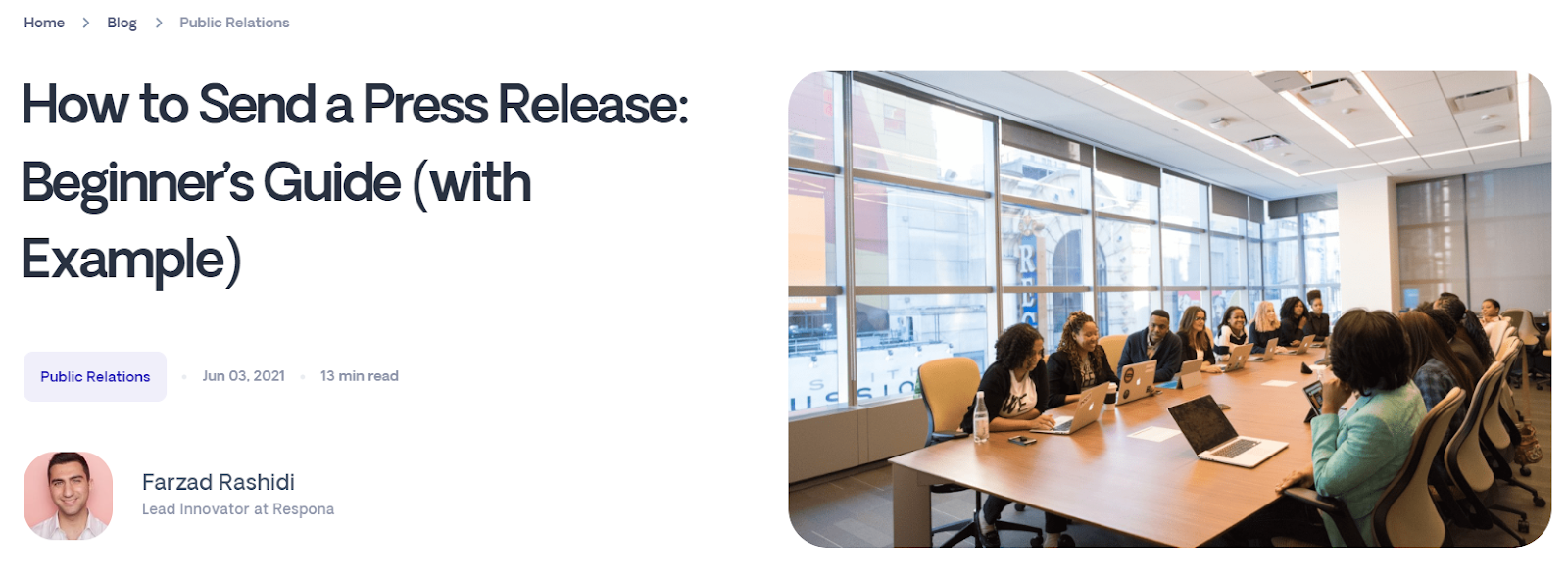
2. Lists
A list post is simply a blog post that is formatted as a list. For example, a post titled “5 Ways to Improve Your Blog” would be a list post.
List posts are popular because they are easy to read and provide value to the reader.
They are also considered “evergreen” content, meaning they are relevant and useful regardless of when they are published.
People love lists! You can list just about anything – the best tools, resources, tips, etc. related to your niche.
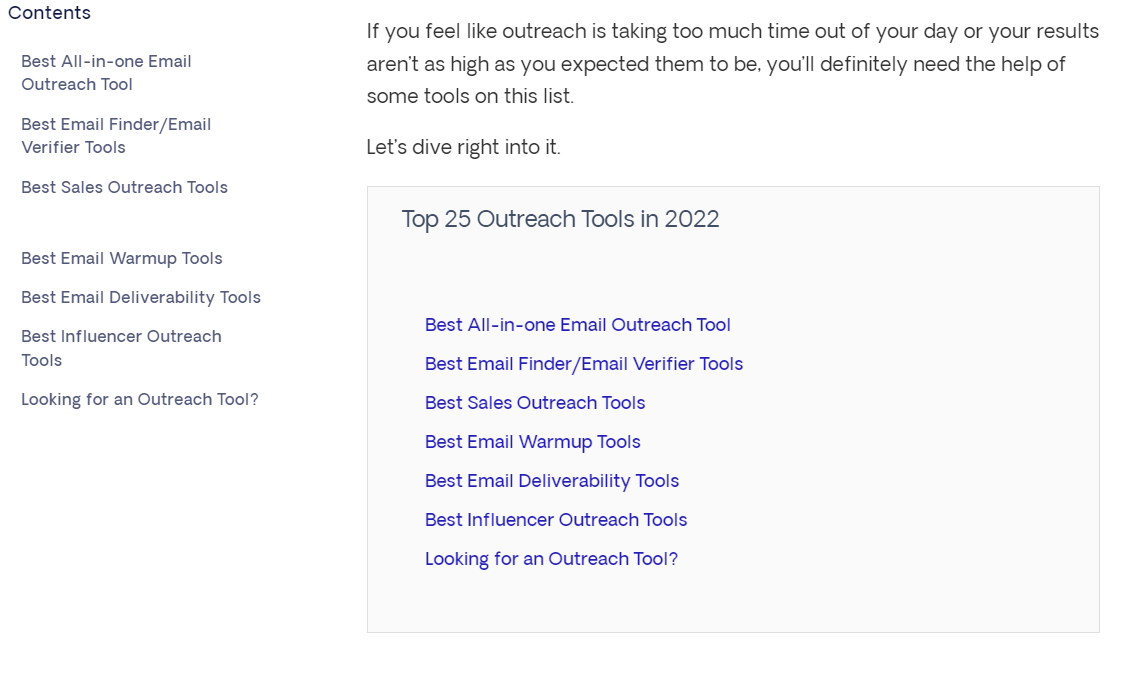
3. Tips and tricks
Similar to how-tos and guides, these pieces of content show your audience a better way to do something.
Tips and tricks articles are popular because they offer concise, actionable advice that can be easily implemented.
They are also relatively easy to update for SEO purposes and can remain relevant for years with minimal effort.
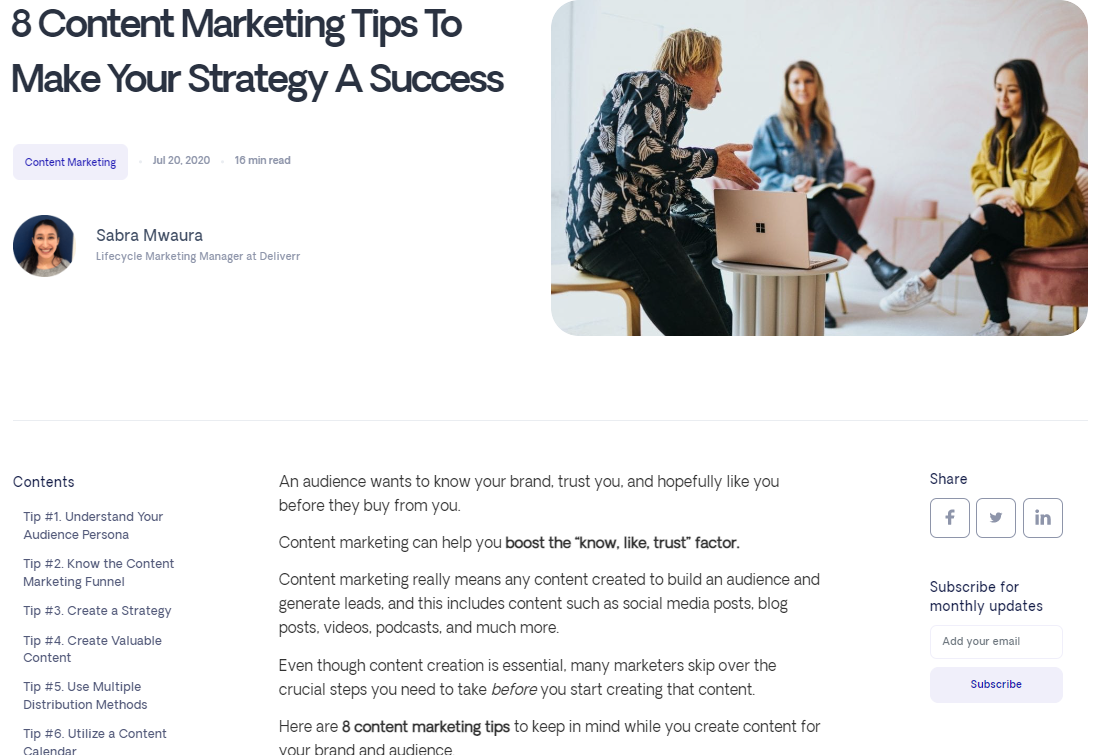
4. Case studies
Showing your audience real-world examples of what you’re teaching can be incredibly powerful.
Case studies are considered to be one of the most valuable pieces of marketing collateral that a company can produce.
Not only are they great for SEO purposes, but they can also be repurposed and used throughout other parts of the marketing funnel.
One of the main reasons why case studies are so valuable is because they are considered to be evergreen content.
This means that they are always relevant and can be used to attract and engage potential customers at any stage in the marketing funnel.
Another reason why case studies are valuable is because they can be used to support other marketing initiatives.
For example, if you are running a paid search campaign, you can use case studies to help improve your quality score.
This, in turn, will help to lower your cost-per-click and increase your chances of conversion.
Finally, case studies are also valuable because they can help build trust and credibility with potential customers.
When people see that you have helped others achieve success, they are more likely to believe that you can help them as well.

5. Expert interviews
Interviewing experts in your industry is a great way to provide valuable content for your audience while also building relationships with influencers.
Expert interviews are considered evergreen content because they offer timeless advice and insights that can be applied to any situation.
They also provide a unique perspective that can be helpful in understanding complex issues.
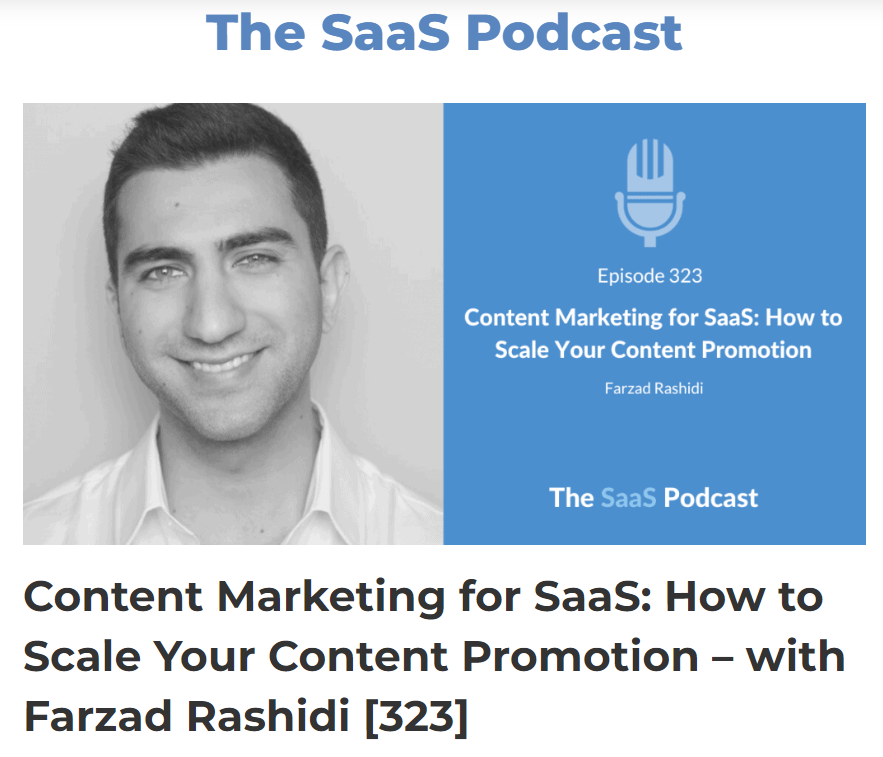
6. FAQs
Answering common questions related to your niche is a great way to provide valuable content that’s easy to digest.
FAQs are considered “evergreen” because they are always relevant and up-to-date. They don’t go out of style or become outdated like other types of content can.
7. Glossaries
If you have a lot of industry-specific jargon, a glossary can be a helpful resource for your audience.
Glossaries are considered evergreen content because they provide definitions for terms that are unlikely to change over time.
This means that they can be referenced again and again, without becoming outdated.
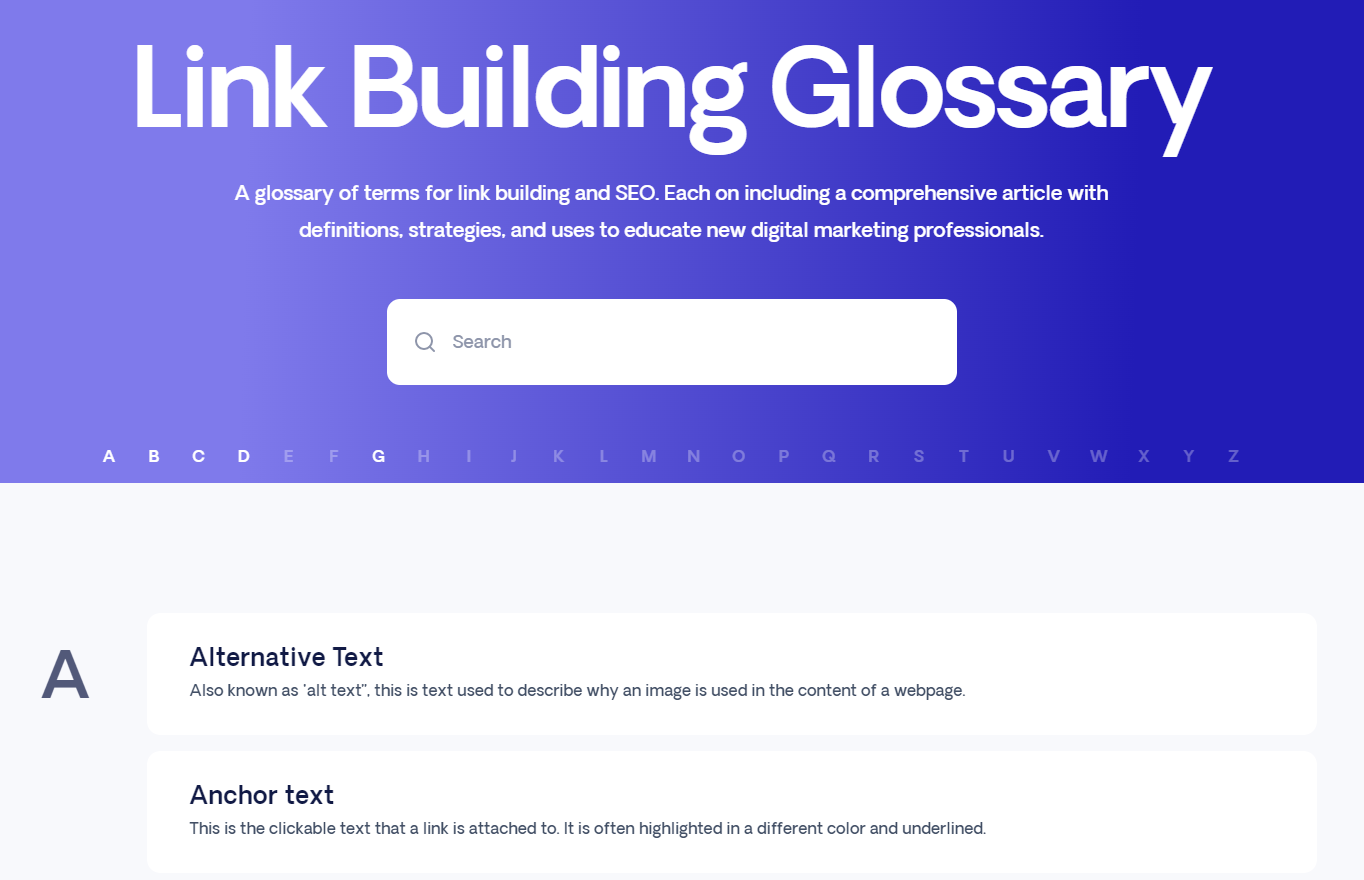
8. How-to videos
Visual content can be very helpful, especially for complex topics. Creating how-to videos is a great way to provide evergreen content that’s easy to consume.
How-to videos are considered evergreen content because they are always relevant and useful. People are always searching for new ways to do things, and how-to videos provide step-by-step instructions on how to do things.
They are easy to find and watch, and they provide valuable information that can be used over and over again.

9. Templates
If you have any templates, checklists, or other resources that your audience would find helpful, make them available on your website.
Templates are considered evergreen content because they can be used over and over again without becoming outdated.
This is because templates are designed to be general enough to be applicable to a wide range of situations, and can be easily updated to reflect changes in the world around them.
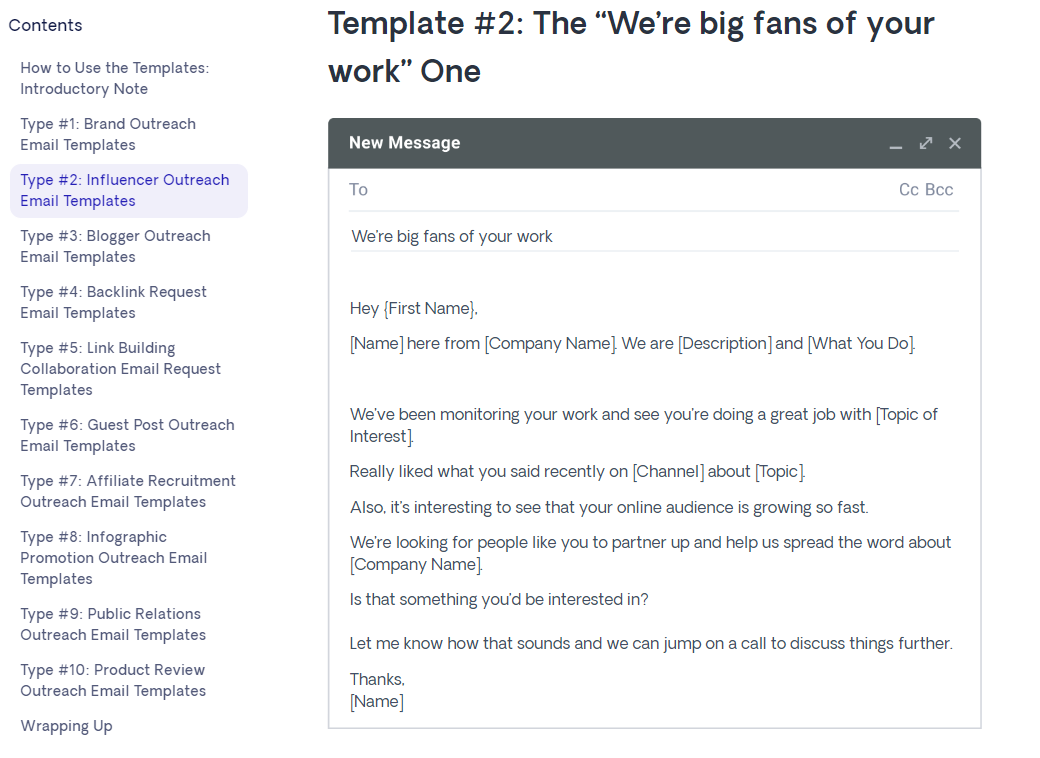
10. Toolkits
Toolkits are considered evergreen content because they provide valuable information that can be used over and over again.
This means that they can be used as a resource for new and old users alike, and they are always relevant.
What isn’t Evergreen Content?
Anything that becomes irrelevant over time can’t be considered evergreen content.
1. Time-sensitive content
This type of content is only relevant for a short period of time and quickly becomes outdated. For example, a news article about a breaking story will only be relevant for a few days or weeks until the story is no longer newsworthy.
2. Seasonal content
This type of content is only relevant during certain times of the year, such as articles about holiday shopping or summertime activities. Once the season is over, the content is no longer relevant.
3. Trend-based content
This type of content is only relevant as long as a particular trend is popular. For example, an article about the latest fad diet will only be relevant for a few months until the next diet trend comes along.
4. Product-based content
This type of content is only relevant until the product it is promoting goes out of style or is no longer available. For example, an article about the latest must-have gadget will only be relevant until the next new thing comes out.
5. Event-based content
This type of content is only relevant until the event it is promoting is over. For example, an article about a upcoming concert will only be relevant until the date of the concert has passed.
Evergreen Content Example
Our top-performing article with 40 reminder email templates can be considered evergreen content:
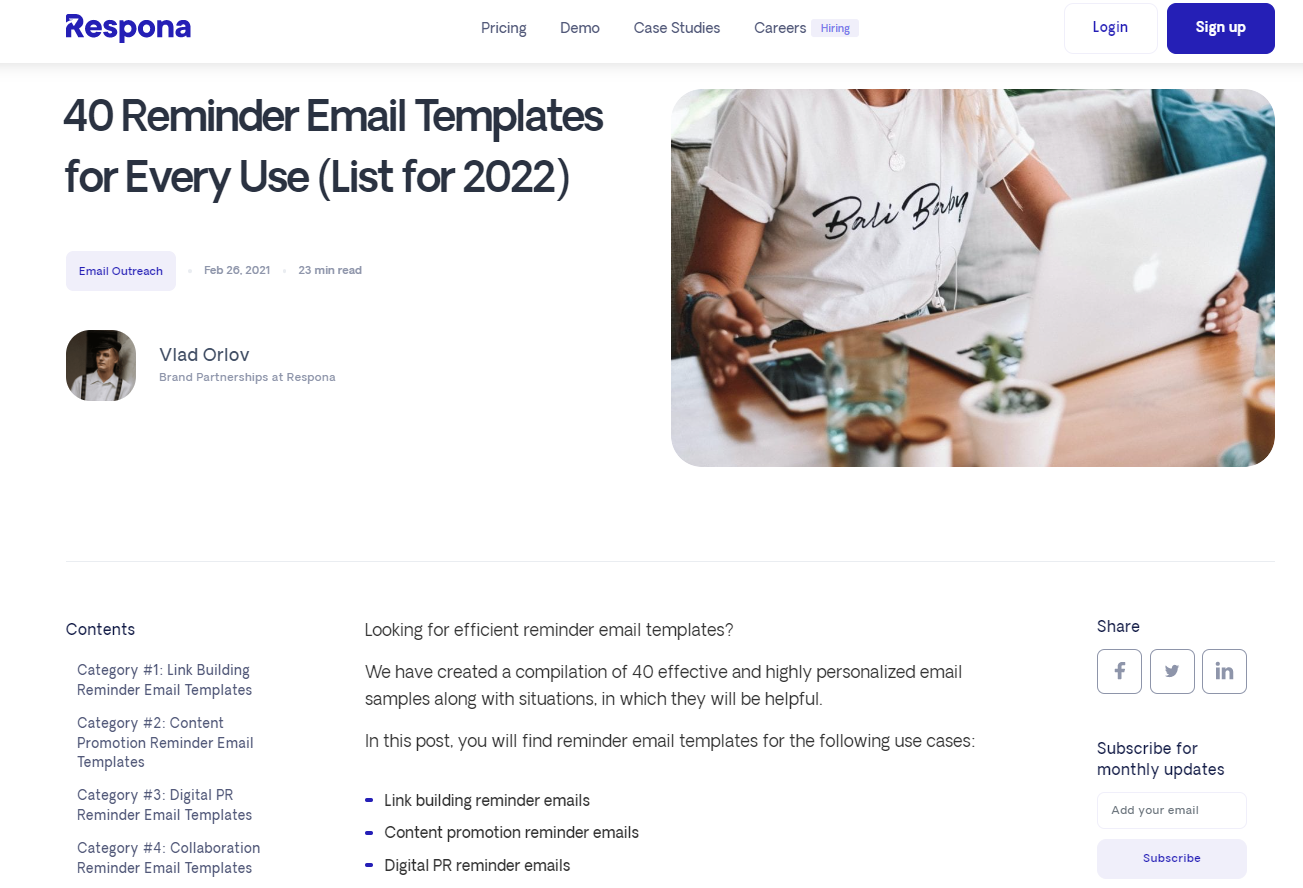
People have been sending reminder emails for years and likely aren’t going to stop doing that anytime soon.
People also love templates that they can grab and use in their own outreach, and having 40 of them in a single blog post is a recipe for success.
In fact, this article has been our best-performing piece for month on end now, generating over 25k organic traffic every single month.
Tips for Creating Evergreen Content
There isn’t really a single recipe for creating evergreen content as the exact steps for creating it will vary greatly depending on the type of content you choose.
Besides the obvious “make it relevant for a long time” advice, we have several other tips that will help you create evergreen content.
Choose the Right Keywords
Keyword optimization is the absolute basis of SEO.
In order to show up on search results pages, you need to know exactly what your target audience is searching for.
So, extensive keyword research should be the first step you take when producing content.
Here’s how you can conduct keyword research with the help of Ahrefs’ Keyword Explorer.

Type your target keyword into the Keywords Explorer. We’ll do “link building” as an example.
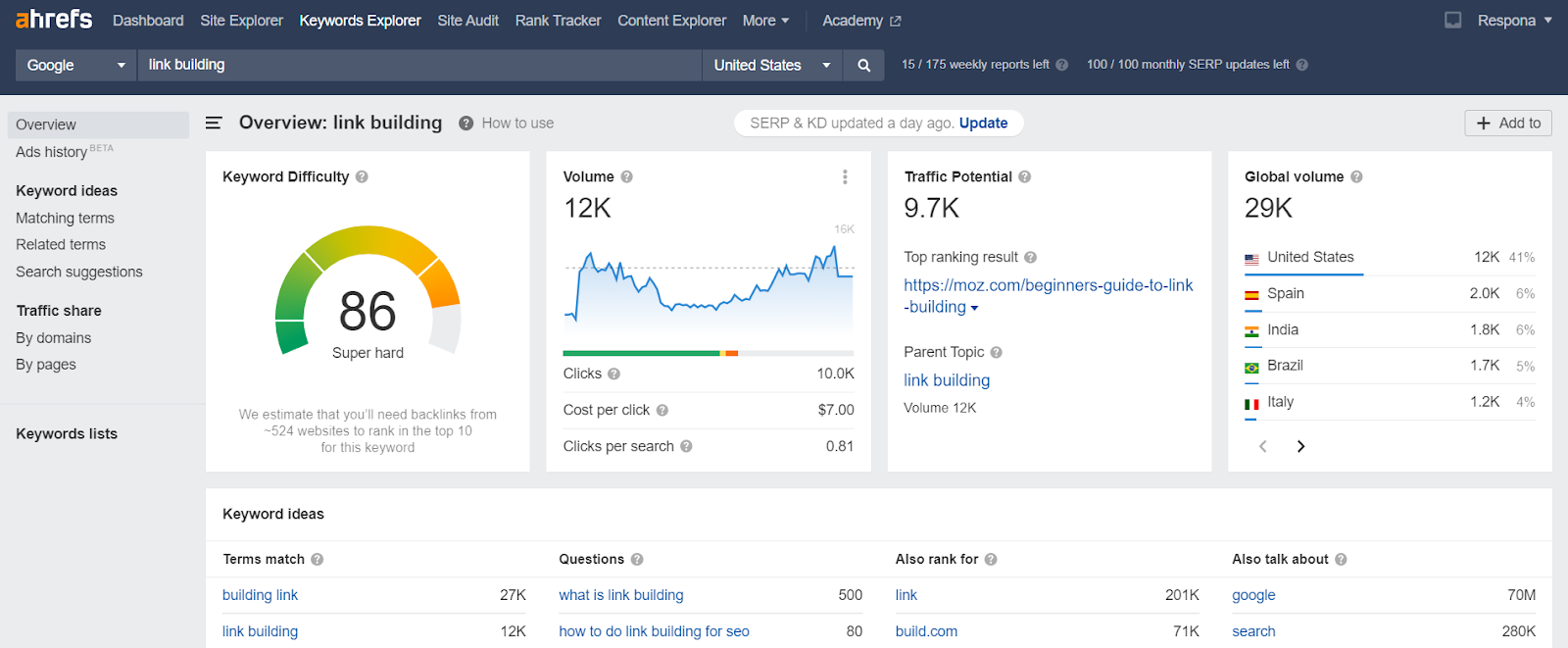
After you click “search”, you will be greeted with the overview of your keyword with the following statistics:
- Keyword Difficulty
- Volume
- Traffic Potential (how much traffic the first result ranking for this keyword gets)
- Cost per click
- Related keyword ideas
As you can see, “link building” has a very high Keyword Density score, 86, making it exceptionally difficult to rank for.
Even if the content you produce is the best in the world, ranking for such a keyword in a reasonable amount of time is next to impossible, simply because of the competition.
It may be a better idea to target keywords that don’t quite have as much search volume but have a much lower Keyword Density.
You can find these keywords if you navigate to “Search suggestions”.
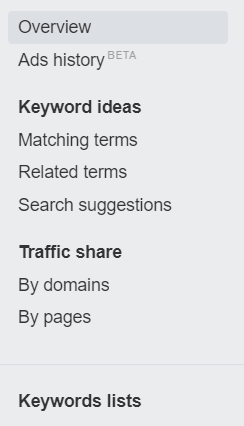
In this menu, you will find an overview of all keywords that are related to your parent keyword, as well as their KD, search volume, cost per click, and other statistics.
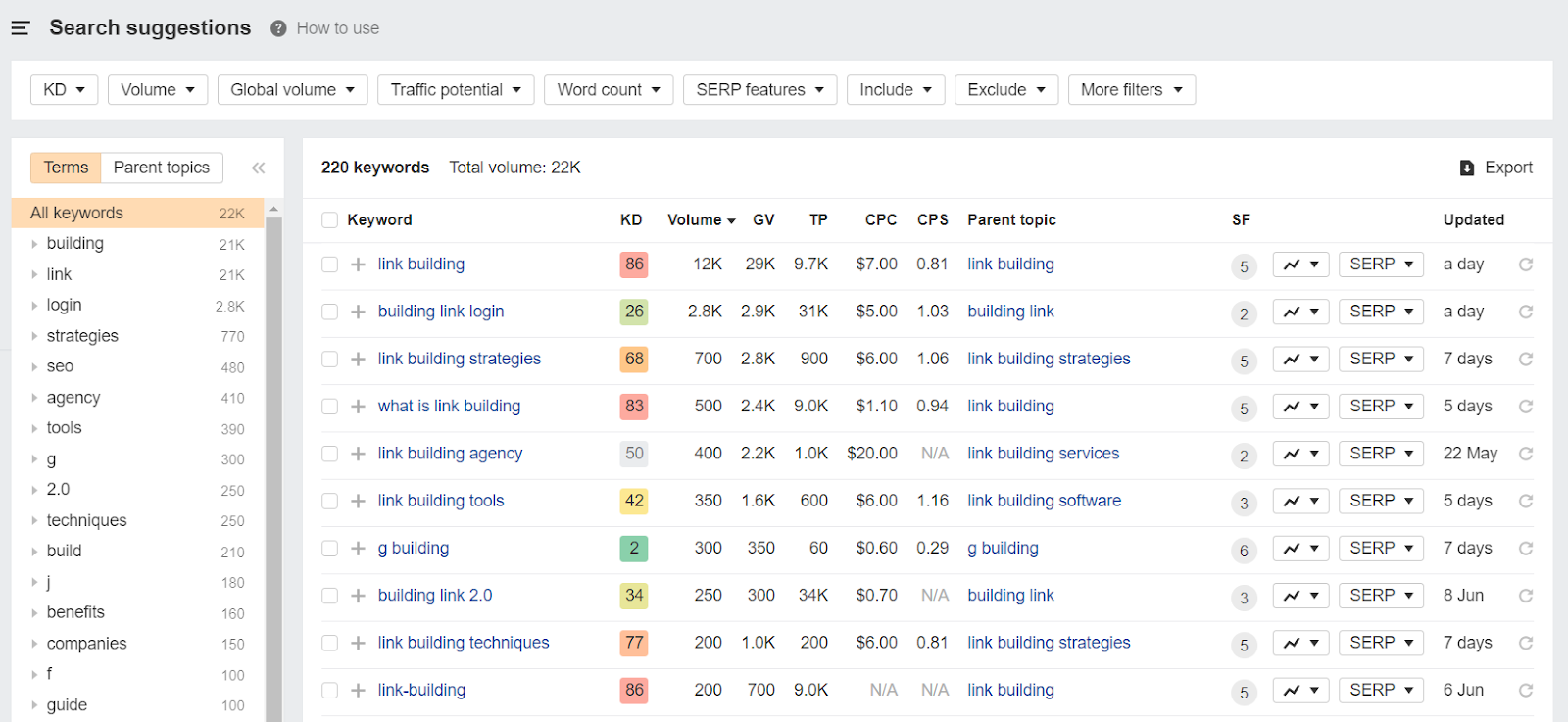
Select Your Target Keywords
Now that you have a list of potential keywords to target, you need to select whichever ones would make for the best opportunities.
You could simply pick keywords that you like and think are relevant.
However, simply guessing isn’t the best approach – you may miss out on opportunities that could be easier to rank for, with less effort.
There is a way to eliminate the guesswork by utilizing a simple formula to quickly grade your keywords and figure out the best keyword opportunities for you at the moment.
This is that formula:
(1/difficulty) * traffic potential * (CPC+1) = Keyword Score
The keyword score is an arbitrary number that helps you determine how relevant a keyword is to you, judging by its density, traffic potential, and cost per click.
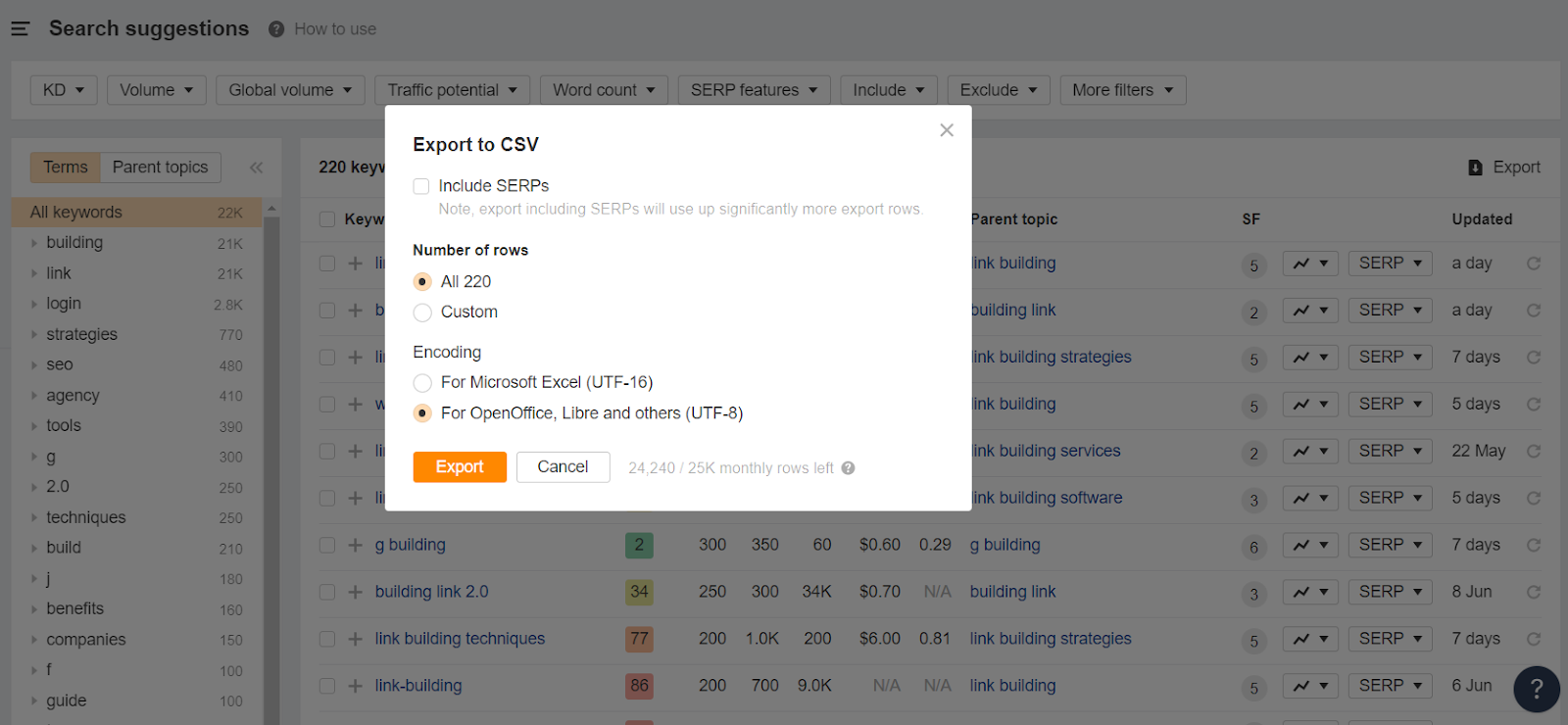
To quickly assign your keywords scores, you can export them from Ahrefs, and add them to your master keyword sheet in Excel or Google Docs.
You can then apply this formula and sort the sheet from Z to A, depending on the score.
The best opportunities will then be at the top.
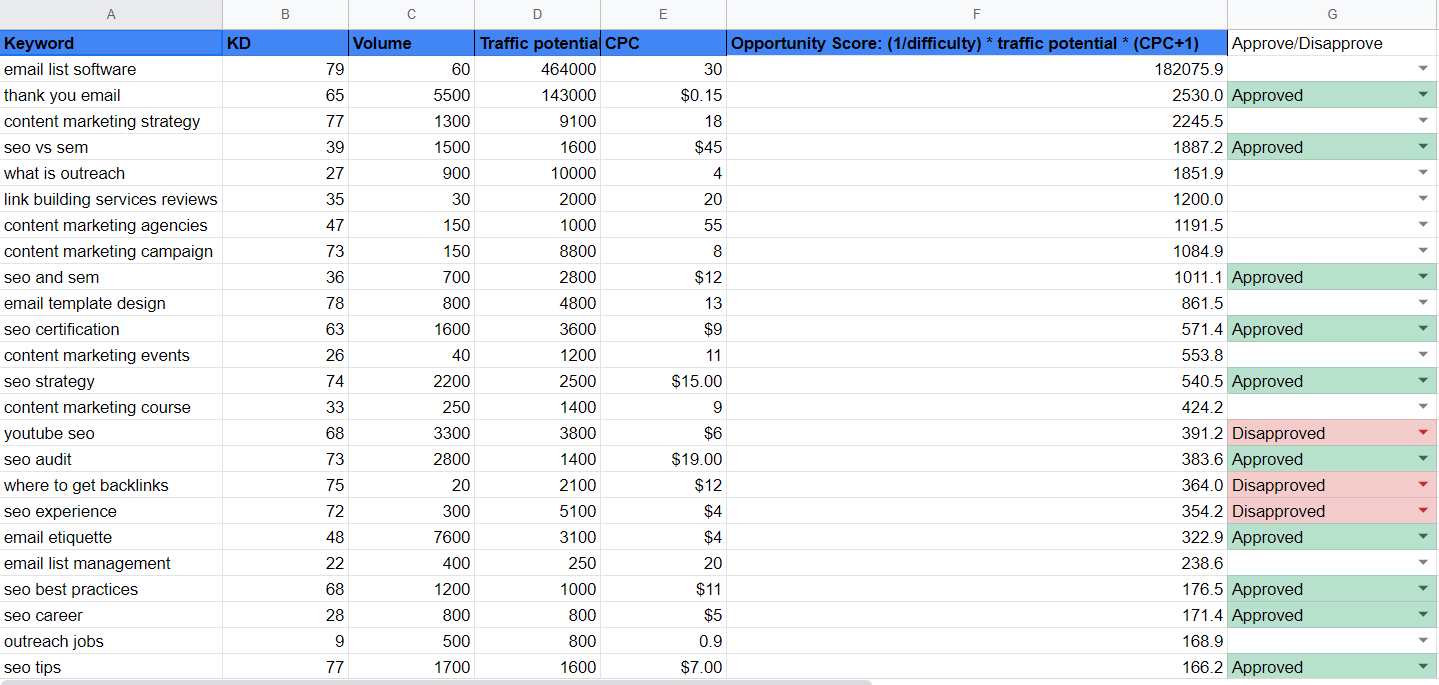
Not all of them will necessarily be super-relevant to your blog, but selecting the ones that are will be a lot easier now that you have scores assigned to them.
Once you have selected your keyword, you can start producing content for it.
Once you have the actual content, you can further optimize it by utilizing software such as MarketMuse or SurferSEO.
It suggests exactly which keywords should be used throughout the content and how many times.
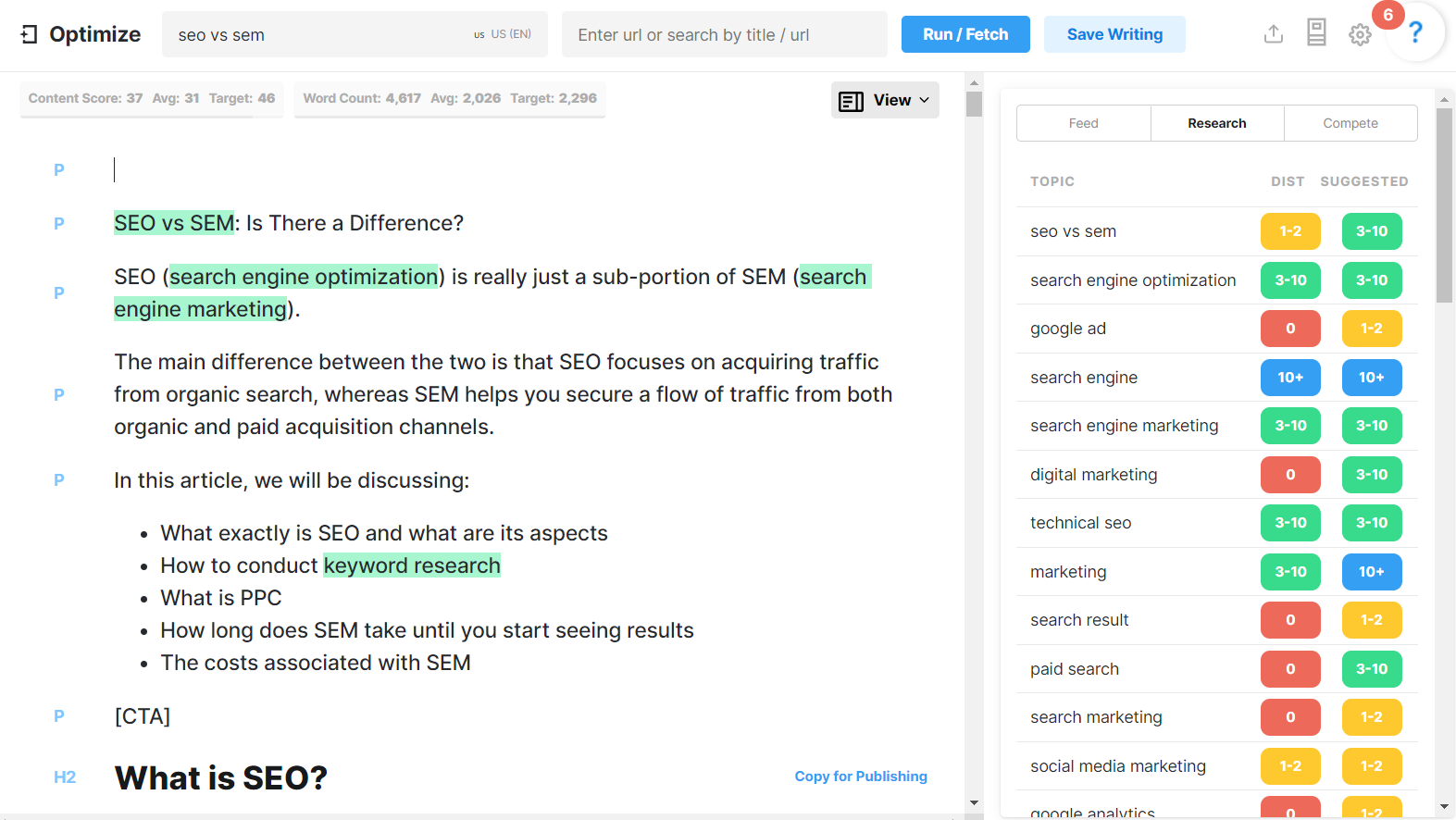
Make Sure Your SEO is Top-Notch
Creating good content is only one half of the evergreen puzzle.
Even if you do succeed in creating something that is relevant and consistently useful year after year, what good is it if it never shows up in search results?
Besides keyword research, SEO consists of three aspects:
- On-Page SEO
- Technical SEO
- Off-Page SEO
On-page SEO (also known as on-site SEO) is the practice of optimizing your on-page content to improve its search engine rankings and earn organic traffic.
The main aim of on-page SEO is to tell search engines what your website is about so they can better understand and rank your site.
There are many different aspects of on-page SEO, but some of the most important ones include:
–Title tags
The title tag is the most important on-page SEO element. It tells search engines what your website is about and appears in the search engine results pages (SERPs). Make sure to include your target keyword in your title tag.

–Meta descriptions
The meta description is the second most important on-page SEO element. It appears below the title tag in the SERPs and gives searchers more information about your website.
Again, be sure to include your target keyword in your meta description.
–Headings
Headings help to break up your content and make it easier to read. They also help to communicate the main topics of your website to search engines.
Use H1 tags for your titles, H2 tags for your headings, and further break down the content with H3, H4, H5, and H6 tags.
–ALT tags
ALT tags are used to describe images on your website. They help search engines understand what your images are about and can also be used to show text in place of images if they can’t be displayed.
Technical SEO is the process of optimizing a website for Google’s search algorithm.
It is a subset of SEO that focuses on improving the crawlability, indexation, and general performance.
There are many aspects of technical SEO, but it all boils down to five aspects.
1. Crawlability and indexing.
Google crawls the web with its Googlebot software in order to index websites and their content.
If your website is not properly optimized for crawling, Google may have difficulty indexing your site, which can lead to lower rankings in search results.
There are a number of ways to optimize your website for crawlability and indexing, such as:
- Using a sitemap.xml file to list all of the pages on your website. This will help search engines crawl and index your website more efficiently.
- Using descriptive titles and meta tags for each page on your website.
- Using keyword-rich anchor text when linking to other pages on your website. This will help search engines understand the relevance of each page and index your pages accordingly.
2. Site speed
Site speed is a huge ranking factor for Google, so it’s important to make sure your website loads quickly. Slow-loading websites can frustrate users and lead to lower rankings in search results.
One of the best tools for monitoring your site speed is Google’s PageSpeed Insights.

Not only does it provide you with accurate data about your core web vitals, but it also diagnoses any speed problems you might have with your website
3. Mobile-friendliness
With more and more people using mobile devices to access the internet, it’s important to make sure your website is mobile-friendly.
Google ranks mobile-friendly websites higher in search results – it’s as simple as that. In fact, Google’s crawlers are mobile-first, so if you fail to optimize your website for mobile, it may not even get indexed properly.
4. Structured data
Structured data is a way of formatting your website’s content so that Google can understand it better. Adding structured data to your website can help Google index your site better and may even lead to richer search results.
There are many Schema Markup generators available on the web that can help you create structured data for your own website.
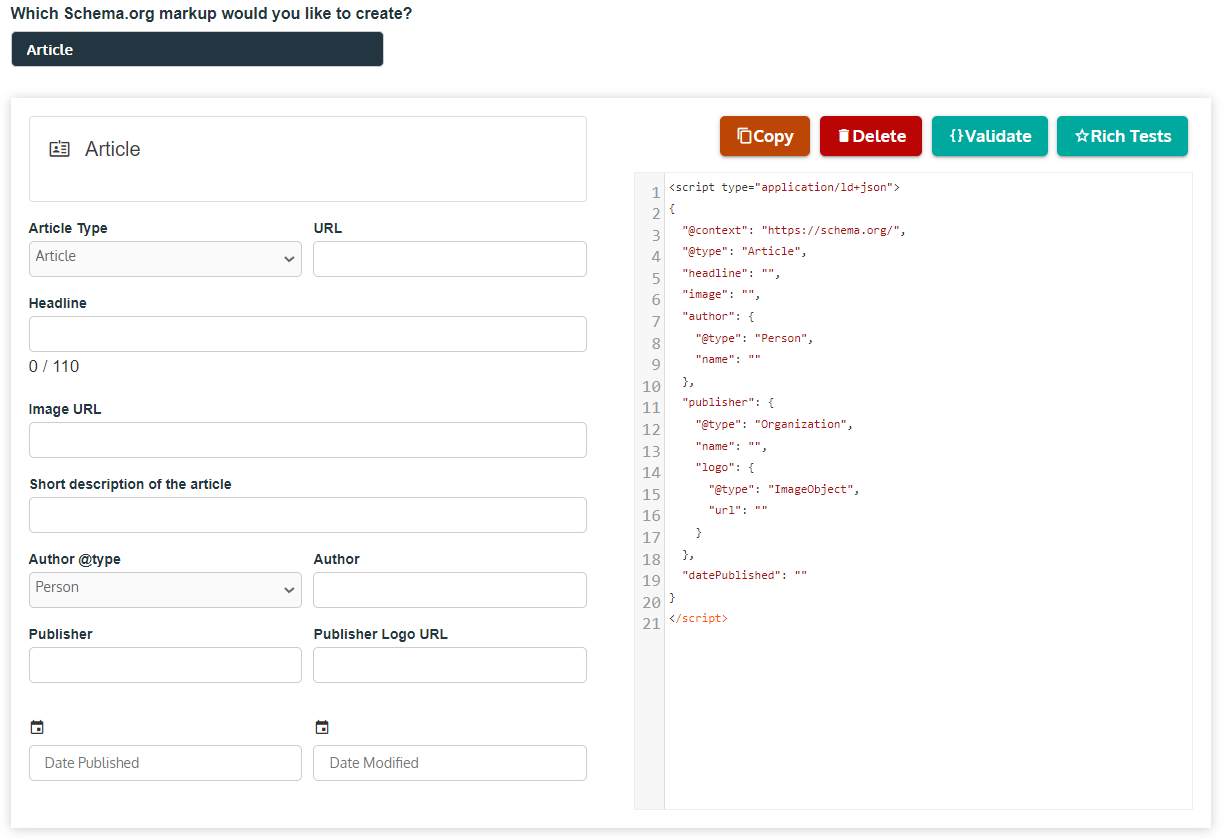
5. Security
No security = no rankings so it’s important to make sure your website is using HTTPS. HTTPS is a protocol that adds security to your website by encrypting communication between your website and visitors’ browsers.
Off-page SEO is mostly about acquiring high-quality backlinks to your website, which we will talk about in the next section.
Build a Lot of Backlinks
Backlinks are one of the most powerful ranking factors to this day.
In fact it is one of the few factors that can help you outrank your competition, even if the keywords you’re competing for are extremely high-density.
There is a clear correlation between high rankings and the number of backlinks a page has.
With a strong enough backlink profile, you will be able to consistently rank high in Google search, and keep providing readers with your valuable insights.
This is because of PageRank, which is the backbone of Google’s algorithm.
In layman’s terms, the more backlinks from highly-authoritative websites a page has, the higher it will show up in search results.
Each page has a PageRank value, and links pass some of this value on to the page that’s being linked to.
In reality, the algorithm is way more complex with hundreds of other ranking factors, but a variation of PageRank is still being used by Google all these years after its invention.
Link building is mainly conducted through email outreach.
Respona’s primary purpose is to help speed up your link building outreach.
There are many link building strategies you can employ, but, as an example, we’ll look at one of the most effective ones: the anchor text strategy.
Its premise is to find articles that mention your target keyword (but are on a different, relevant topic), reaching out to them, and asking them to link to you, while offering some sort of incentive – usually in the form of an indirect link back.
1. In Step 1 – Find Content, click on Automation Setup. This way, the tool will automatically scrape results for you, greatly reducing the time your prospecting stage will take.
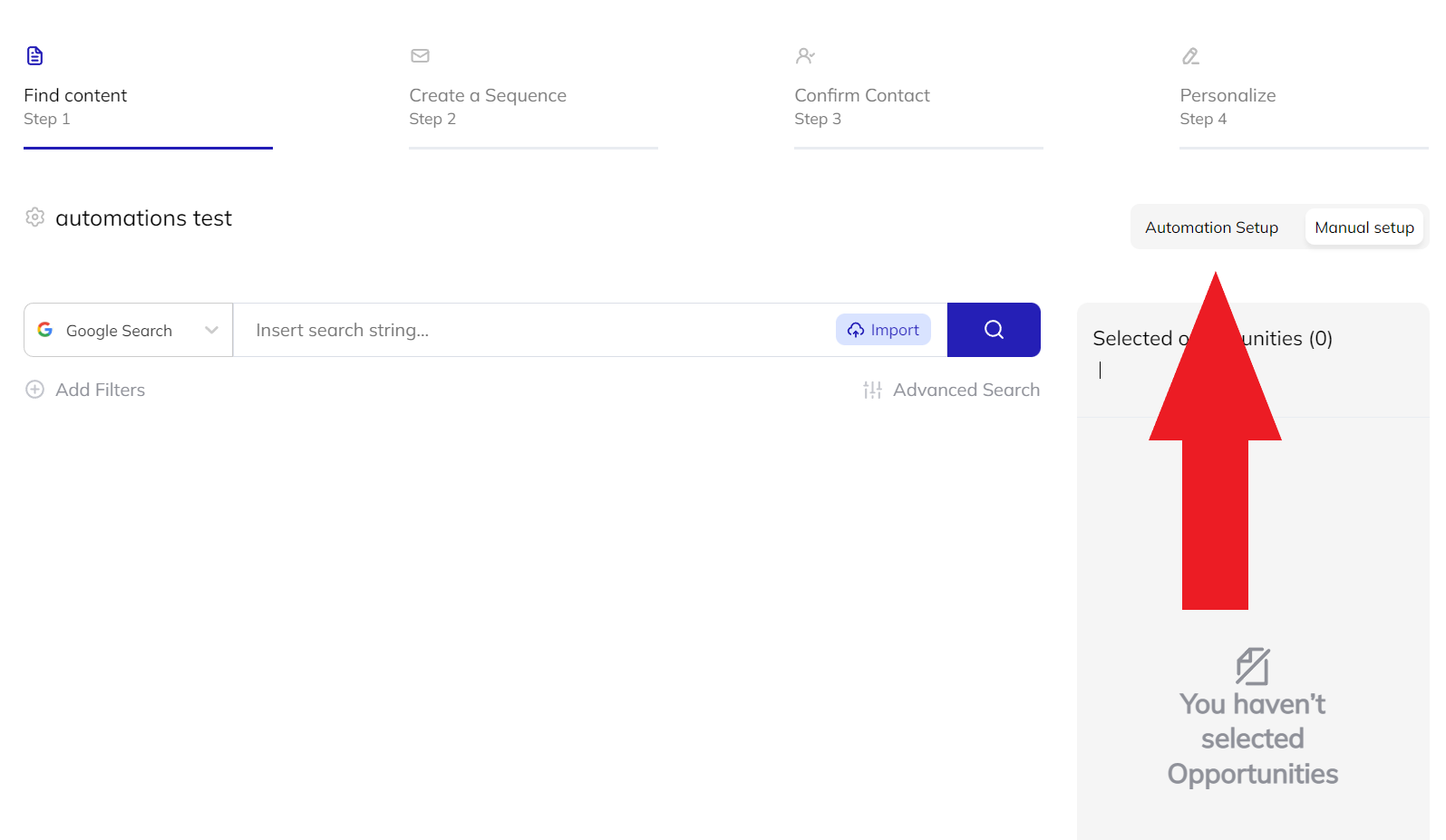
2. Select “Keyword Search”
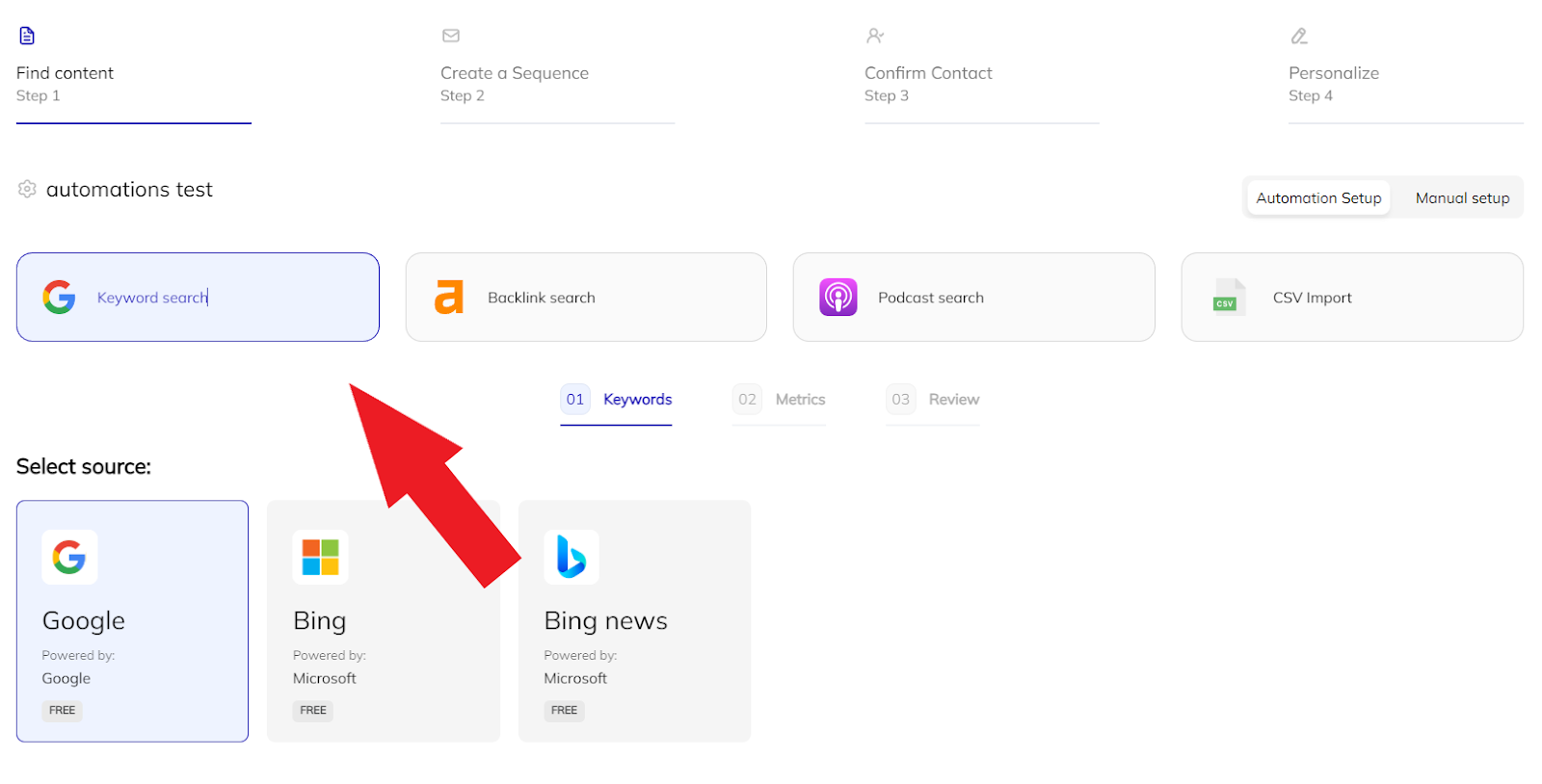
3. Select Google or Bing – we will use Google in our example.
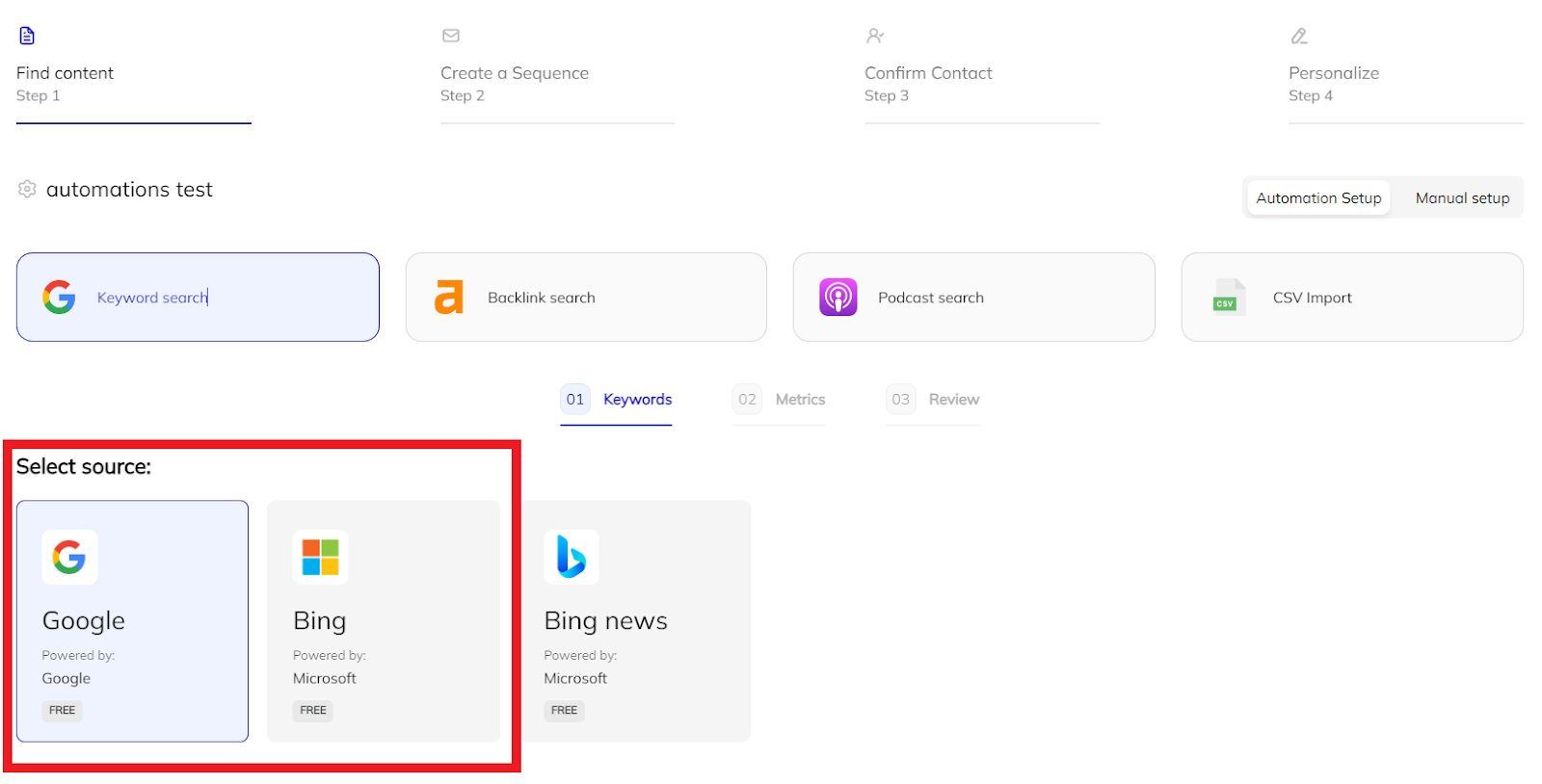
4. Note: Google and Bing use different advanced search operators. You can find them under “Advanced Search”.
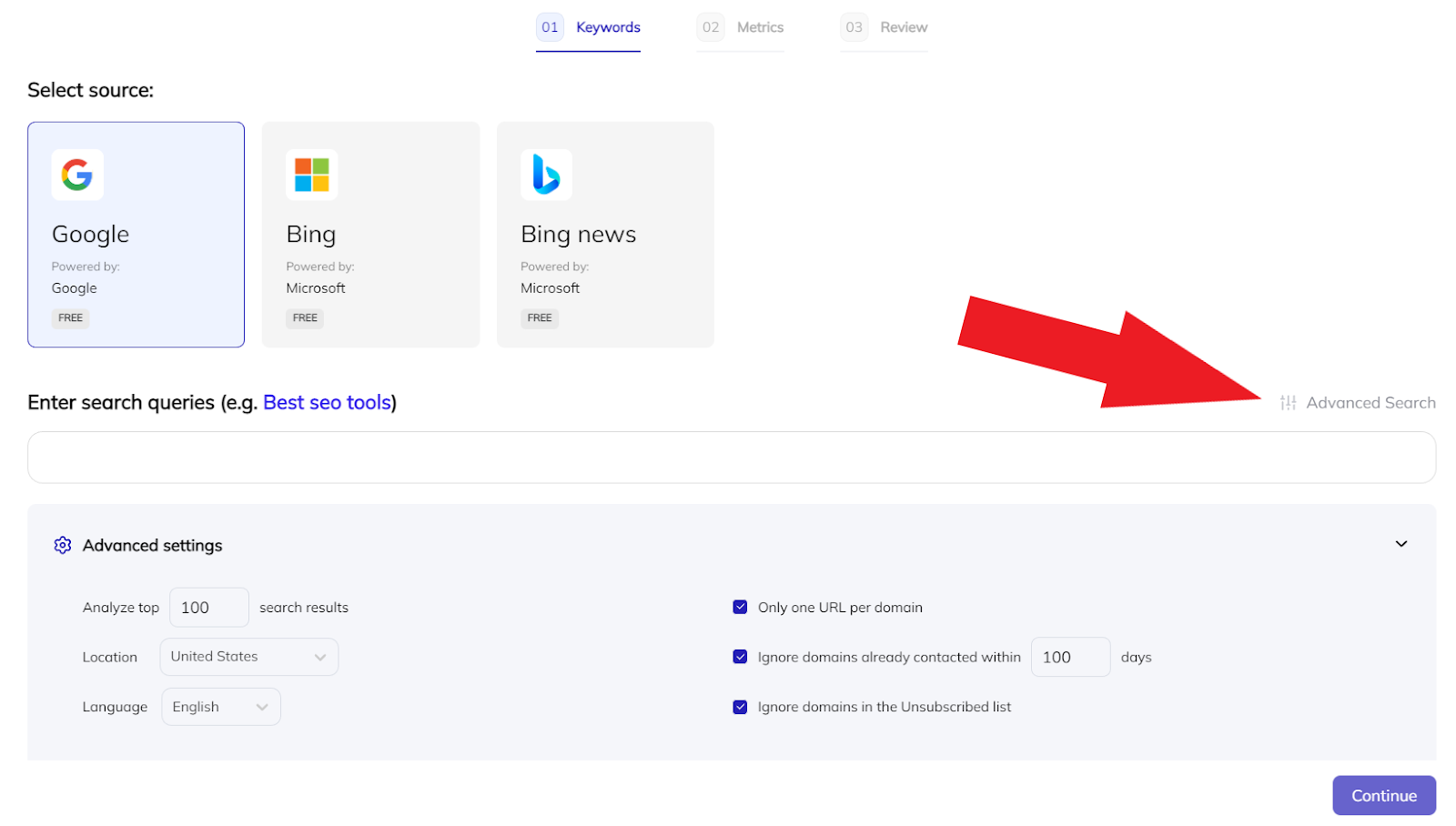
5. You can run multiple queries at the same time with the keyword automation. With the help of advanced search operators, you can get extremely specific with the kinds of results you expect to pull.
The following are the most useful advanced search operators for this strategy:
- inurl:blog (tells the search engine to only show pages that are part of a blog)
- intext: (specifies which keyword should be included in the articles’ bodies)
- intitle: (specifies which keyword should be included in the articles’ titles)
- -intitle: (specifies which keyword should not be included in the articles’ titles)
A few simple search strings would look like this:
1. inurl:blog intext:”saas marketing” -intitle:”saas marketing”
2. inurl:blog intext:”saas marketing” intitle:”content”
3. inurl:blog intext:”promoting your saas” intitle:”software”
These would only return blog posts that mention SaaS marketing or SaaS promotion in the bodies, but are on slightly different topics.
It’s important to select articles that are on different topics than your target keyword – nobody in their right mind would link out to competing content.
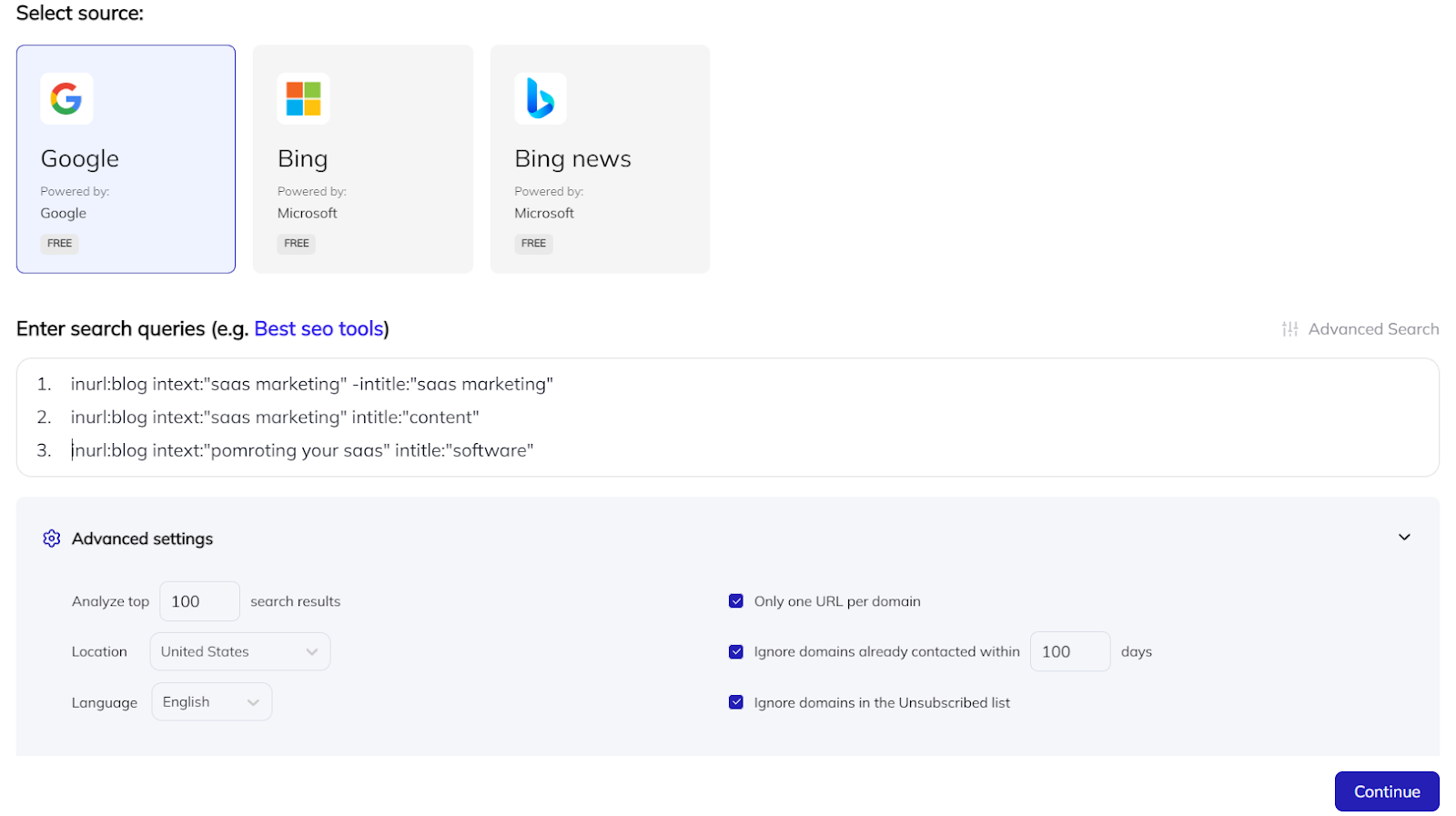
6. Set any advanced settings such as the number of results to analyze, location, language, and safety filters.

7. Click “Continue”.
8. If you connect your Ahrefs account to Respona, you can also set additional filters. The Domain Rating filter is accessible to all users, even without an Ahrefs account.
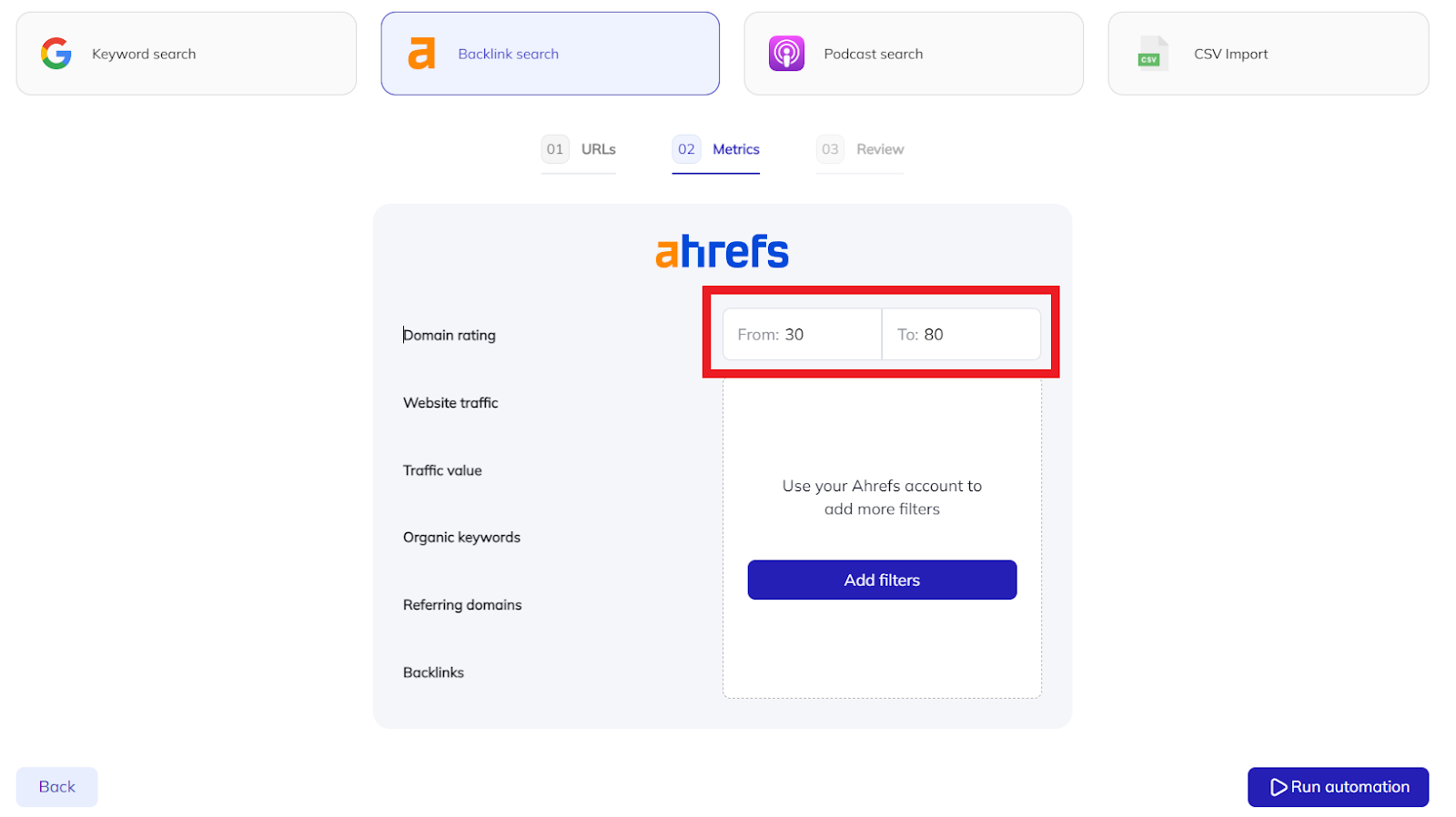
9. Click “Run Automation”.
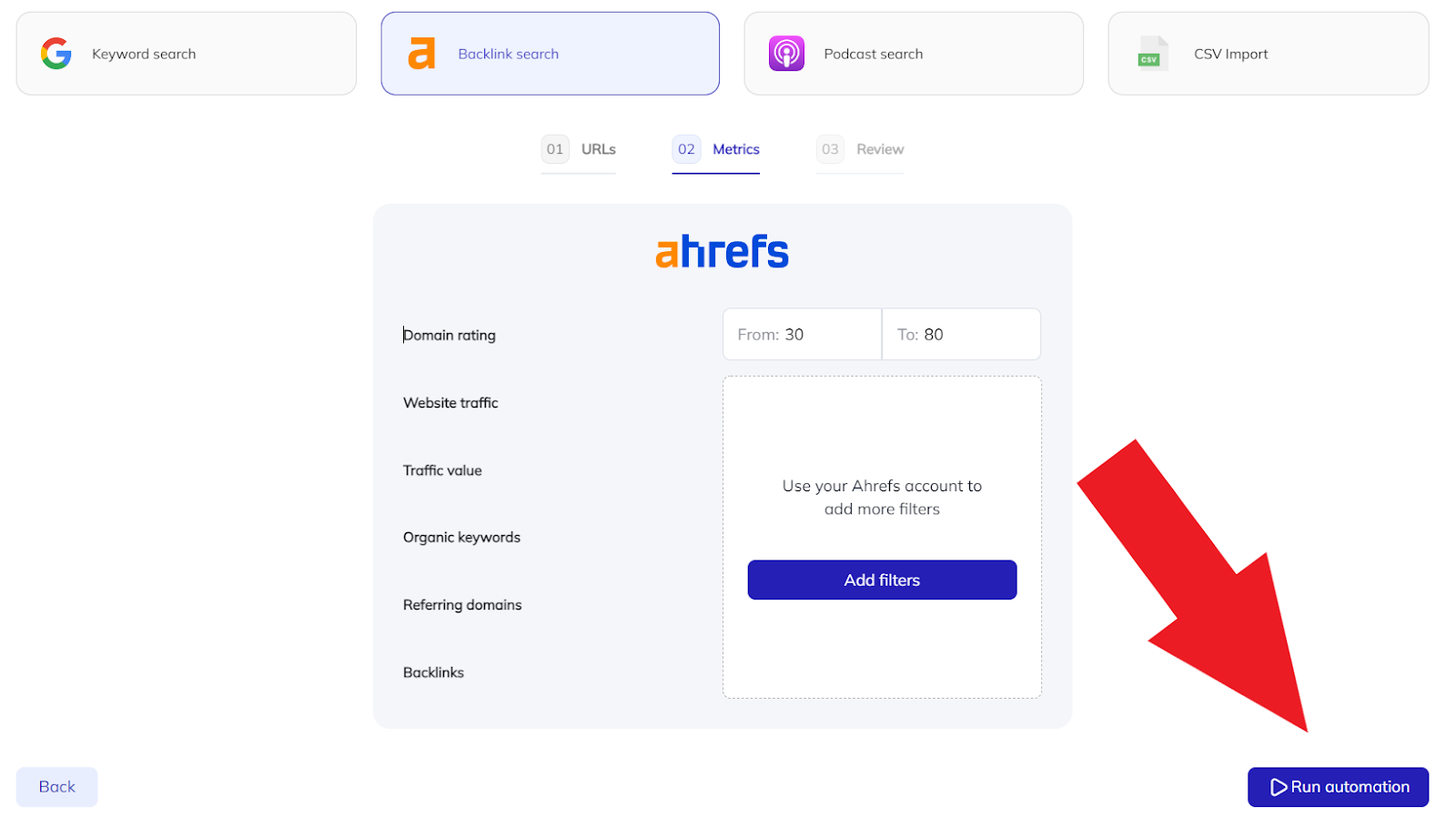
10. Once the automation is done running, click “View Results”.
Use Simple Language
There are a few reasons for why you should use simple language and write with beginners in mind when creating evergreen content.
The first reason is that it will make your content more accessible to a wider audience. If your content is too technical or difficult to understand, then people will be less likely to read it and more likely to click away.
By keeping your language simple, you can make sure that more people will be able to understand and engage with your content.
Another reason to write in a simple, beginner-friendly style is that it can help to build trust with your audience.
If you come across as an expert on a topic, then people will be more likely to trust what you have to say.
However, if you use complicated language or jargon, then people may get the impression that you’re trying to sound more important than you are, and this can damage your credibility.
Finally, using simple language can help to make your content more shareable.
If people can easily understand your content and share it with their friends, then it has a much better chance of going viral and reaching a larger audience.
However, if your content is too difficult to understand, then people will be less likely to share it.
So, overall, there are many good reasons to use simple language and write with beginners in mind when creating evergreen content.
Doing so will make your content more accessible, build trust with your audience, and make it more likely to be shared.
Repurpose and Syndicate Your Content
Creating evergreen content takes a lot of time and effort.
So, naturally, you want to get as much bang for your buck as possible.
You can do so by repurposing and syndicating your content.
There are a number of ways that you can repurpose and syndicate your content in order to get more out of your evergreen content. For example, you can:
-Create a blog post series out of your evergreen content. This will allow you to break up your content into smaller, more digestible pieces that your readers can easily consume.
-Create an ebook or an online course using your evergreen content. This will allow you to reach a wider audience with your content, generate additional revenue, or even use as CTA freebies.
-Repurpose your evergreen content into different formats, such as infographics, videos, or podcasts.
People’s attention spans are getting shorter, and, especially with more complex topics, people prefer having things laid out in front of them in an informative video rather than having to read a 10,000-word blog post.
-Syndicate your evergreen content on other websites or blogs. This will help get more eyes on your content, and generate some sweet backlinks along the way.
Bottom Line
So, evergreen content is content that stays relevant and informative for long periods of time and is not prone to sudden changes, like seasonal and time-sensitive content.
However, just writing a good article is not enough – you also need to optimize it for SEO, build backlinks to it, promote, syndicate, and repurpose it to truly reap all of the benefits of evergreen content and actually start ranking with it, generating valuable traffic.

